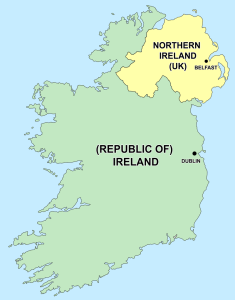By Donna Welles.
Ireland has an unemployment rate of 13%. Its European neighbors have unemployment rates that dot the spectrum; Norway has 4%, the United Kingdom has 8%, and Spain has 26%. In 2000, Ireland’s unemployment rate was 4%.
Allow us to examine Ireland’s economy in terms of the following indicators, (1) trade balance, (2) trade with the United Kingdom and Germany, and (3) social indicators. In 2014, Ireland’s GDP was $246billion USD, up from $99billion in 2000.
Ireland’s exports greatly exceed its imports. The World Bank’s WITS database reports that 2014 Irish exports totaled $118billion, whereas its imports totaled $71billion. Of the $118billion in exports, 58% is chemicals, 13% is manufactured goods, 11% is machinery, and 10% is food and live animals.
Specifically, pharmaceuticals accounted for $29billion, organic chemicals accounted for $24billion, perfumes and cosmetics accounted for $9billion, and scientific instruments accounted for $6billion. Of the $71billion in imports, 27% is machinery, 21% is chemicals, 13% is manufactured goods, 12% is mineral fuel, and 11% is food and live animals.
External trade with Germany has fluctuated significantly since 2000, although that with the United Kingdom appears stagnant. Irish exports to Germany have decreased by 13% whereas imports from Germany have increased by 98%. Irish exports to the United Kingdom have increased by 16.6% whereas Irish imports from the United Kingdom have increased by 61%.
In terms of social indicators, Ireland’s armed forces personnel totals have dropped to 9,350 servicemen in 2013 from 11,500 in 2000. Dublin has increased in size since 2000 to 1.2million in 2014. Ireland’s total population in 2014 was 4.6million and its life expectancy was 81.



